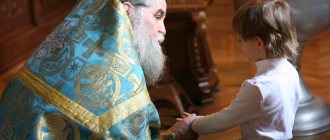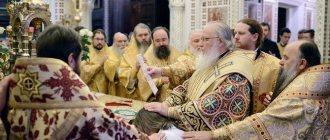Like any other community, an Orthodox church has its own rules of communication and etiquette. The general approaches can be understood intuitively - in church you are not supposed to talk loudly, come in too flashy or provocative clothes, you need to behave calmly and not disturb others in their prayers. Much of Orthodox etiquette can be learned by looking at others.
Most often, newly-made Christians have difficulties in personal communication with clergy. The priests and everyone involved in the service in the temple seem to us almost celestial beings who are very different from mere mortals. And very often we do not know how to approach the priest, how to address him, how to start a conversation or ask a question. Let's try to understand the subtleties of church etiquette.
Each rank has its own address
Each rank has its own address, accepted in church protocol. To understand which one to choose, you need to determine who is in front of you: a deacon or an archimandrite. In the Orthodox Church there are three degrees of clergy:
- Deacon (archdeacon, protodeacon, deacon, hierodeacon);
- Priestly (protopresbyter, archpriest, archimandrite, abbot, priest, hieromonk);
- Episcopal (patriarch, metropolitan, archbishop, bishop).
And two categories of clergy: black (monastic) and white. The white clergy is the most numerous: it includes clergy who did not take monastic vows.
They are allowed to have a family and children, they are closest to worldly life. The monastic clergy assumes complete celibacy; they devote their lives to serving God and take three monastic vows - chastity, obedience and non-covetousness (voluntary poverty).
The deacon does not wear a pectoral cross and is addressed as “Father Deacon”
| Secular clergy | Religious clergy | Application form |
| Deacon, Archdeacon, Protodeacon | Hierodeacon | to the archi-, protodeacon: father archi-, protodeacon (name)..., to the deacon, hierodeacon: father (name)... |
| Priest | Hieromonk | Your Reverence, Father (name)... |
| Protopresbyter, archpriest | Hegumen, archimandrite | Your Reverence, Father (name) |
| Abbess | Venerable Mother (name) | |
| Bishop | Your Eminence, Most Reverend Bishop (name) | |
| Archbishop, Metropolitan | Your Eminence, Your Eminence Vladyka (name), (Your Beatitude, Your Eminence Vladyka (name) | |
| Patriarch | Your Holiness (name), Most Holy Bishop (name) | |
| Monk, novice | honest brother (father) (name) | |
| Nun, novice | sister (name) |
Taken together, the three degrees, making up the three-rank hierarchy of the Orthodox Church, form the clergy. Therefore they are called clerics, or otherwise clergy. In addition to the clergy, there are also clergy - subdeacons, readers (singers), and candlebearers.
They are lower clerics and assist the clergy in performing divine services. As a rule, parishioners do not turn to them.
In addition, clergy, priests and higher officials of the Church have strict divisions in their responsibilities:
- Deacons proclaim prayer requests during services and help the priest during the Sacraments;
- Priests (priests, archpriests) can perform the Sacraments;
- Bishops not only perform the Sacraments, but can also ordain deacons and priests.
The difference between a deacon and a priest is the presence of a pectoral cross
The priest must wear a pectoral cross and you can address him as “father.” It is
quite simple to distinguish a deacon from a priest: the deacon does not have a pectoral cross. The archimandrite wears a cross with decorations, the archpriest (abbot) wears a gilded or decorated cross, the priest (hieromonk) wears a silver cross.
In order not to be mistaken, you can use the simplest address: Father (name), and if you know the position, then (rector, vicar, dean): Father rector, father deacon, etc.
Sometimes getting a hint on the question of how to greet a priest (a person of clergy) will help you get acquainted. The clergy themselves, when introducing themselves, state their rank and name: Archpriest Vasily, Archdeacon Nikolai, and so on.
The priest is the successor of the apostles
Of course, clergy are an ancient phenomenon that arose much earlier than Christianity and even earlier than the first book of the Bible was written.
Any culture about which evidence has been preserved communicated with supernatural forces, and most often through intermediaries: priests and shamans.
And even earlier, religion, everyday life, land ownership, art and other spheres of life were intertwined so closely that every person was both a priest and a breadwinner, and generally moved in a universal environment where everything was connected to everything else.
You go after prey: draw it on the wall to attract good luck - this is a symbiosis of creativity, superstition and the search for food.
Priests arose as responsibilities were distributed in society. It became clear that a person copes much more effectively with a limited number of tasks, and if they are evenly distributed in society, it will become easier for everyone to live together.
Christians took advantage of the experience of ancient traditions and over a couple of centuries formed a complex organization of the church - a mediator between God and believers.
As the representative of the Almighty on earth, the priest has a difficult mission.
He is obliged to convey in its pure form all the richness of the Christian heritage, but at the same time think flexible and wise enough to apply knowledge in everyday situations.
If the doctor is responsible for the health of the body, then the priest’s task is no easier: being the successor of the apostles, he cares about the good of the soul.
Apostle Andrew the First-Called is the first disciple of Jesus Christ, in fact the first Christian, whose example is followed by modern priests
It is not customary for clergy to say “Hello” or “Good afternoon” when meeting
One of the important points is the form of greeting that the laity allows towards the priest in the church. Often people who come to the temple turn to the clergy: “Hello, good afternoon!” This is incorrect, because. According to church etiquette, after the words of greeting, you need to take a blessing, saying “bless...”.
You can say: “Good afternoon, father, bless!” or “Forgive me, bless me…” or even shorter: “Bless me, father (name).” It wouldn’t be a sin if you added the time of day or a holiday greeting, for example: “Good morning, father, bless!” or “Christ is risen, father (name),” bless!” You can ask a priest for a blessing even outside the church and if he is dressed in secular clothes.
When you meet a priest, bend down a little, fold your right hand over your left, palms up, and say: “Father, bless.”
Patriarch Kirill should be addressed as “Your Holiness” or “His Holiness Vladyka Kirill.”
Another common appeal among us, “mother,” is permissible only in relation to the abbess of the monastery, but not to a nun. It is also customary to address the wives of priests and deacons as “Mother (name).”
Basics of Church Etiquette
Christian canons began to emerge as early as the time of the twelve apostles, based on deep faith and reverence for the Almighty. Unfortunately, not all traditions have reached the 21st century, but religious etiquette is still an important part of the Orthodox community.
Failure to comply with established rules may cause a negative reaction from church members or put the layperson in an awkward position. To prevent this from happening, you need to understand how to behave correctly when visiting a church and understand the intricacies of the church charter.
Etiquette of addresses in the Russian Orthodox Church
The rules for oral communications also apply to written ones.
These rules must also be followed in written requests. Official letters are written on a special form, informal letters are written on plain paper or on a letterhead with the name and position of the sender printed in the upper left corner (the reverse side of the sheet is usually not used). It is not customary for the Patriarch to send a letter on letterhead.
When writing to the hierarchs of the Local Orthodox Churches, the title of the Primate of the Church (Patriarch, Metropolitan or Archbishop) is always written with a capital letter. The title of the First Hierarch of the Autonomous Church is written in the same way. If the First Hierarch bears the double (triple) title of Patriarch and Metropolitan (Archbishop), then all these titles are also written with a capital letter: His Beatitude Philaret; Archbishop of Minsk.
Clergy of lower ranks are addressed briefly: His Most Reverend Archpriest (or Priest) (name, surname, position); in this case, the surname of the monastic person, if indicated, is always given in parentheses.
In accordance with accepted rules, a letter consists of: indication of the addressee, address (address-title), text itself, compliment, signature and date. In an official letter, the addressee includes the person's full title and position, in the dative case, for example, “To His Eminence, Most Reverend (name), Archbishop (name of the department), Chairman (name of the Synodal Department, commission, etc.).”
An address or address-title is an honorary title of the addressee. They start a letter with it and use it in the text. “Your Holiness” (in a letter to the Patriarch), “Your Majesty” (in a letter to the monarch), “Your Excellency,” etc. A compliment is an expression of politeness with which a letter ends.
An example of a compliment: “I ask for your prayers. I abide with true reverence and love for the Lord.” The author's personal signature is accompanied by a printed transcript. The date the letter was sent includes the day, month and year, and in official letters the outgoing number is also indicated.
Every believer considers it obligatory to ask for blessings when meeting with the priest.
Where to send messages to the Patriarch
Any letter to His Holiness goes through the office, so one should think about whether it is worth addressing it to the Patriarch himself, because there are issues whose resolution is entrusted to other persons in the church due to the Bishop’s busy schedule.
You can write a letter to the Patriarch using a traditional envelope and paper, or seek help through the official website, which is organized under the Moscow Patriarchate. All information about toll-free telephone numbers and postal addresses is also published here.
Related posts:
Generally accepted rules and forms of appeals
Address to the priest in the temple:
- Address only “you”;
- Wait until the priest is free (finishes the service, talks with another person);
- It is not customary for priests to shake hands, so you can bow a little before starting a conversation and after the words of greeting ask for a blessing;
- Call by name, for example, “Father Sergius.” If you don’t know him - “Father”;
- Names and titles are pronounced only in Church Slavonic: deacon, not deacon; Alexy, not Alexey;
- When parting, ask for a blessing, as you would when greeting;
- If you meet a priest on the street or in transport, without vestments, you can approach and take a blessing (if this does not interfere with his work). If you cannot take the blessing, simply nod slightly.
Contacting a priest by phone:
You can call the clergyman by phone in case of need or close acquaintance.
- On the phone you can’t see who’s answering, so you can start the conversation with the words: “Hello, is this Father Andrey?” and after receiving a positive answer, say: “Father, bless!”;
- You need to introduce yourself, say your name;
- Next, you can tell us why you are calling;
- Communicating with a church minister over the phone is not the best way, so do not discuss frank topics and do not confess like that. You can arrange a meeting, or find out other useful information. And leave everything else for a face-to-face conversation;
- When saying goodbye, as in church, you can ask for a blessing and hang up.
Application forms
- Appeal to a monk who does not have clergy: “honest brother”, “father”;
- Address to a novice and nun: “sister”;
- Address to a deacon (archdeacon, protodeacon): “father (arch-, proto-) deacon” or simply “father (name)”;
- Address to the priest (priest) and hieromonk (monastic priest): “Your Reverence” or “father (name)” (unofficial address – “father (name)”, “father”);
- Address to the archpriest (priest), abbot and archimandrite: “Your Reverence” (unofficial address to the archpriest - “father (name)”, “father”);
- Address to the abbess of the convent: “Venerable Mother (name)” or “Mother (name)”;
- Address to the bishop: Your Holiness, Your Beatitude, Your Eminence, Your Eminence;
- Address to the bishop: Your Eminence, Most Reverend Vladyka or simply Vladyka (or using the vocative case of the Slavic language: Vladyko);
- Address to the Metropolitan: Your Eminence or Your Eminence Vladyka.
The rules, concepts and subtleties of church etiquette are described in the work of Bishop Mark Golovkov “Church Protocol”.
By leaving a comment, you accept the user agreement






